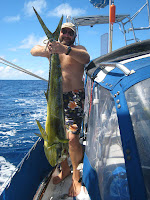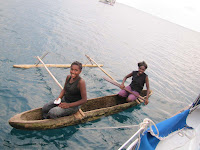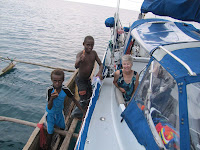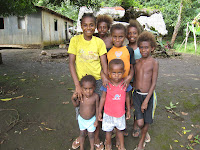May 3, 2010—The last two days of our crossing to Vanuatu gave us frequent rain squalls but no big winds, which was a good thing. Our plan to go to Tanna Island changed on Saturday morning when the winds changed direction on us making a run to Tanna very difficult. In addition, the day after we were to arrive, the winds were forecast to come from the northeast, which would have made that anchorage very uncomfortable if not unsafe. Therefore, we decided to change course and go directly to Port Vila on the island of Efate.
Unfortunately, we lost our wind on Saturday and had to motor sail for the next 48 hours. During this period of time, what little wind we did have would swing from south to southeast to east and even to northeast and then back again. We were continually changing our main sail, which meant gibing the main and the preventer (used to prevent an accidental gibe) from one side to the other. On one occasion we had just gone through all the gyrations to switch, and then five minutes later the wind switched back to the other side. Steve never sleeps well when we are on passage, so with all the deck work plus the loss of sleep, he was getting a bit punchy by late Saturday.
Sunday was our anniversary, and we had planned to be in Tanna relaxing, but now we would be at sea for an additional 15 hours. As we were approaching Efate late Sunday afternoon, the winds piped up to over 20 knots, and we had rain squalls all around us. The good news is that our new radar unit works beautifully so it is easier for us to see how big the squall is and in which direction it is moving. The bad news is that going into a new port at night is bad enough, but the higher winds and unsettled weather raises the level of stress even more.
As night fell, the winds continued to blow, and we had some nasty looking squalls coming up behind us. We decided to drop the already reefed main sail so that we did not have to gibe it when we made our turn around Pango Point, but we did leave the jib up. Pango Point has some rip tides, and we wanted to be able to concentrate on the waves and not the sails.
Now in addition to everything else going on, the charts and cruising guides state that there is a light on Pango Point—maybe. Well, it is not there. They also talked about the leading lights that you line up in order to come into the harbor. In this case, two of the three lights were not working. Thank goodness for chart plotters and radar! Without these instruments, we would have had to heave to and wait for daylight, which we did not want to do.
As we made the turn around the point, there were some pretty big rolling waves coming up beside the boat. A few broke close to the side, but we were able to avoid getting soaked by any. It also began to rain slightly, which added another element to the mix. Anyway, we made it around the point, found our way into the harbor and through the port and starboard beacons. The quarantine anchorage was right at the end of the harbor so it was easy to find. We had our quarantine flag flying and would wait until morning to get cleared in. Scarlet O’Hara had arrived earlier in the day, so we pulled next to them and dropped our anchor in a lucky spot. It was 40 feet deep but got deeper as we were backing down on the anchor.
It was now 10:15 in the evening (but only 9:15 on Vanuatu time). We got the boat secured and picked up the cockpit a bit. Since it was our anniversary, we enjoyed a celebratory cocktail and then went immediately to bed. Steve, of course, slept heavily that night, and I didn’t have any trouble myself.
Monday morning we called Port control to let them know that several boats had arrived and would need to clear in. They told us that they would notify Customs, which they did. The Immigration official arrived at the boat, came aboard, and gave Steve the usual papers to fill out. She was very friendly and pretty reasonable about letting us keep most of our food items on the boat. Sometimes, they will take any fresh meat, dairy, fruits, or vegetables. That would have been a costly thing for us as we had provisioned heavily in Fiji where the items were cheaper.
After clearing Immigrations, we started the engine and moved to the Yachting World mooring field just a bit east of our anchorage. They have fuel, water, and laundry. Since we plan to be here just four or five days, we decided to stay on a mooring. We checked in and then headed to town, which was much more cosmopolitan than we expected. Unfortunately, the cruise ship arrived this morning, so people were everywhere. We made it a short trip.
We did find a tour to Tanna Island to see the volcano that included an overnight stay so we booked the trip for Wednesday and Thursday. We really wanted to see Mount Yasur Volcano on Tanna, so this will be how we accomplish that. Also, by taking this tour, we can go up to the volcano at night, which we would not have been able to do with the boat.
The last thing we needed to do today was to check in with Customs. The office is located at the pier where the cruise ship is docked, so we decided to take our dinghy the short distance around the bay. We arrived at the dock, puttered beneath the bow of the cruise ship, and found a very helpful security guard who told us that we could tie up our dinghy on the seawall. We then climbed up the concrete steps and walked into the Customs office. The officer there was also very helpful and friendly. The process went smoothly, and we were done in about 15 minutes. We were worried that with the ship in town, Customs would be swamped; however, it was no problem.
We took it easy for the rest of the day and then enjoyed some of our Mahi Mahi for dinner. Steve fell asleep around 7 o’clock so I decided to finish the blog tonight in order to post it tomorrow. So far, Vanuatu is a very nice surprise.
I have included some pictures from the passage. Steve with his latest Dorado, under sail with the moon setting, and Momi Bay--our last anchorage in Fiji.
.jpg)


.jpg)

.jpg)




.jpg)


.bmp)